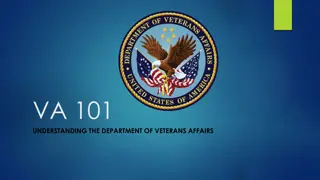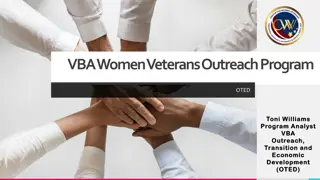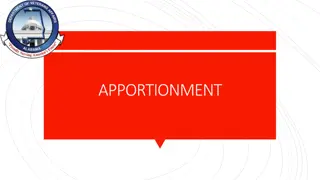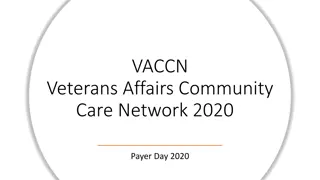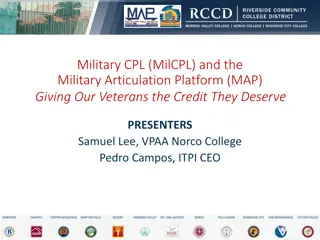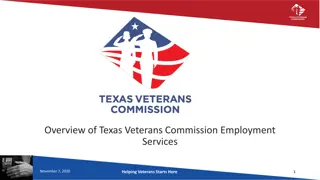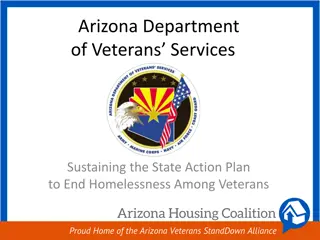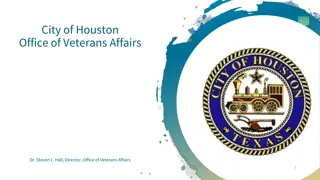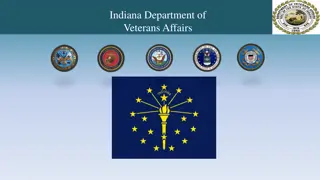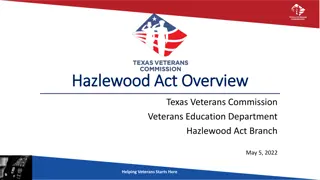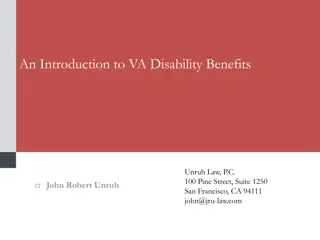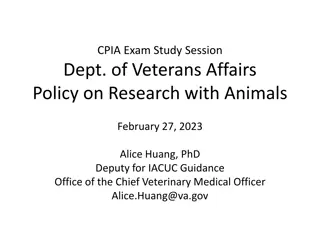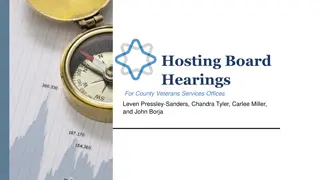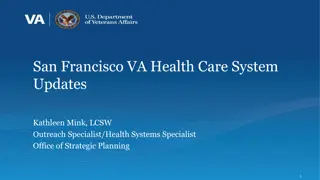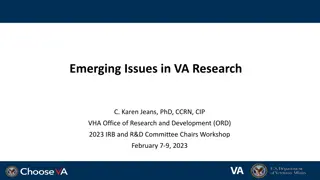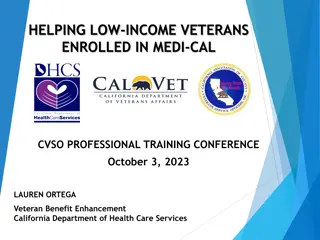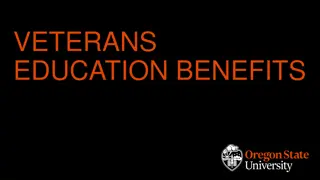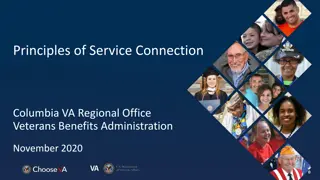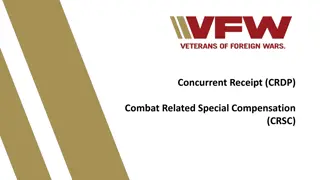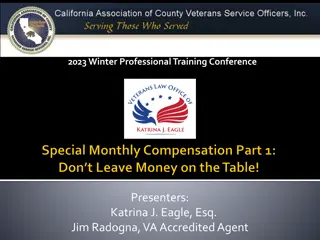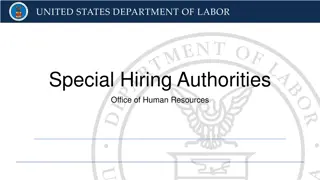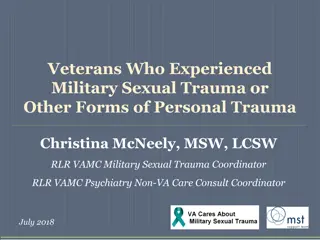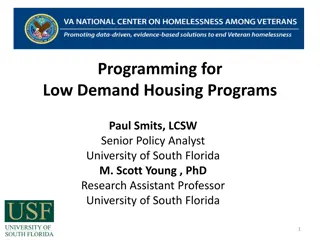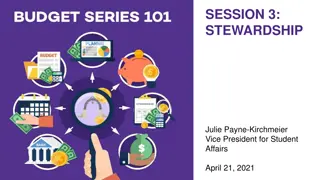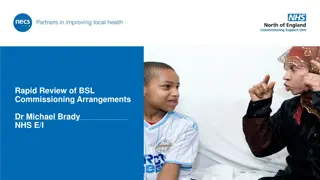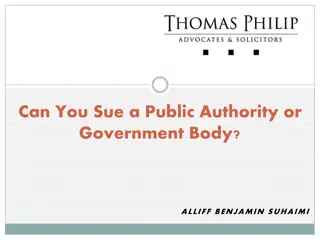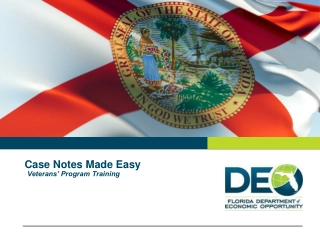Veterans Affairs Decision Review Options
Explore the various decision review options available through the Veterans Affairs, including Supplemental Claim, Higher Level Review, and Appeal to BVA. Understand the criteria for choosing the appropriate option based on evidence availability and appeal period. Tips on identifying the reason for denial and best courses of action to address missing elements.
Download Presentation

Please find below an Image/Link to download the presentation.
The content on the website is provided AS IS for your information and personal use only. It may not be sold, licensed, or shared on other websites without obtaining consent from the author. Download presentation by click this link. If you encounter any issues during the download, it is possible that the publisher has removed the file from their server.
E N D
Presentation Transcript
Reviewing Decisions June 20, 2023
VA Decision Review Options (Appeals Modernization Act of 2017) Supplemental Claim Higher Level Review Appeal to BVA Options if you have additional evidence Option if you have no additional evidence Direct Review Lane A new review will be conducted by another VA adjudicator Requires new and relevant evidence Evidence Submission Lane VA will assist in evidence gathering Evidence cannot be introduced to the record Hearing Lane
Choosing A Decision Review Option | Veterans Affairs (va.gov) 3
Quick Thoughts: Which Decision Review Option to Choose? oIs it past the one-year appeal period? Yes, then only option is supplemental claim No, then all 3 options possible oIf there are multiple issues denied, you can file separate Decision Review requests (based on review of reason for denial). oBut you cannot choose two decision review options for the same issue. 4
Quick Thoughts: Which Decision Review Option to Choose? oIs the evidence needed to support the claim already on file? Yes choose Higher Level Review oIs additional evidence from the veteran necessary to support the claim (includes non-VA medical)? Yes choose Supplemental Claim oIs additional evidence necessary, but it is something the VA can obtain given the information is already on file? Yes choose Higher Level Review 5
Consider This: o Filing an appeal to the Board (VAF 10182) = at least 1-2 year wait. Hearings currently scheduled still have a 2019 docket date. o Think Is there a missing element? If there is, it will be denied, lucky to get a remand. o Best course of action? Identify the missing element and submit relevant evidence to address the missing element.
Identifying the Reason for Denial oFor each issue, identify the reason for denial, which element was not met? Injury or disease during active duty (AD) Current disability Link between current disability and active duty injury or disease. oIdentifying which element was not met, tells us what evidence is needed to rebut the denial or support the claim for service-connection. 7
Review: Evidentiary Record of Claim Evidentiary record: VA s receipt of the claim up to the date of the decision notice. Why does the evidentiary record matter? When the evidence requested is received after the notice of decision, it is not part of the evidentiary record and a VAF 20- 0995 (Supplemental) should be submitted. If the evidence came in before the decision, and was not considered in the RD (i.e. not identified in the evidence list). You can point it out and submit with VAF 20-0996 (HLR). 8
Deep Dive: How do we assess which lane is the best option? 9
Elements of Service Connection Title 38 USC 1110, Title 38 CFR 3.4(b) and 3.303: Basic entitlement exists if the veteran has a disability incurred in or aggravated by active duty service, and is not the result of willful misconduct or abuse of alcohol or drugs. Three elements of service connection: Injury or disease during active duty Current disability Link between current disability and active duty injury or disease.
Review: Service Connection There are several principles for service connection (ways to get SC). Here s four: o Direct service connection (38 CFR 3.304 & 3.305) o Aggravation of pre-existing injury (38 CFR 3.306) o Presumptive service connection (38 CFR 3.307-3.309) o Secondary service connection (38 CFR 3.310)
Chronicity To be considered a chronic disease in service a combination of these should be shown: o Manifestations sufficient to identify the disease entity, and o Sufficient observation to establish chronicity at the time Examples of chronic diseases that can be in the STRs: Diabetes, heart disease, cancer, multiple sclerosis, *arthritis* 12
Continuity When chronicity in service is not shown, then VA looks for a showing of continuity of symptoms for the remainder for service and after discharge. Continuity of symptomatology is required: o For conditions noted during service, but not shown to be chronic. o Or where the diagnosis of chronicity may be legitimately questioned. 13
Statement of continuity of symptoms The sample above addresses the continuity of symptoms, in this case there were only a couple of quick notes in the STRs about the left ankle issue while the veteran was in service. But what would be better than the veteran s statement? 14
Better evidence? A medical statement from the veteran s doctor, indicating the current condition was incurred in service or stems from the in-service injury, continued on (based on history of treatment) and rules out other possibilities. 15
Higher Level Review Informal Conference: How does that work?
DROC Stations: Seattle their station calls the veteran or identified VSO Washington DC their station calls the veteran or identified VSO St. Petersburg uses WaitWhile scheduling application. This means our corporate mailbox on the VA side gets an automated email before the DROC calls. If you are the rep, we ll forward the email to you, and you can use the link to schedule the IC.
HLR Requests with IC M21-5, Chapter 5 Higher Level Review Procedures
HLR Requests with IC Unsuccessful first attempt by DROC will be document using VAF 27-0820. If no response by third business day, DROC makes a second and last attempt to schedule the IC. If unsuccessful, they document with VAF 27-0820 and then DROC can render a decision on the HLR. Upon successful contact, IC can be that call or be scheduled within 7 calendar days of the successful contact. Decisions involving HLR Returns (VAF 20-0999) should see EP 040, auto-established within 48 hours of EP 030 promulgation.
HLR RD: Duty to Assist Errors (DTA) VAF 21-0999 in VBMS but no EP 040-DTA after two business days? In early December, VA discovered an issue with the automatic establishment of Duty to Assist Errors (DTA). For HLRs closed before March 20, there are 2,300 instances where the appropriate DTA or DOO has not been established. VA batch establishment of claims in mid-April.
What Constitutes an Appeal? Title 38 CFR 20.202 & 20.203: Notice of Disagreement must be properly completed on a form prescribed by the Secretary (VA Form 10182) Must identify the specific decision and issue or issues therein with which the claimant disagrees. Must be within one year from the date that the agency mails the notice of the decision. 21
Increased Ratings under AMA Increased ratings (IR) are the most affected by siwthc from Legacy to AMA. Why? BVA can no longer consider the worsened condition when the medical evidence does not refer to the severity of condition during the evidentiary record. So, evidence of IR must already be on file or veteran s doctor submits a statement that specifically states severity of veteran s disability from the time of claim not just the current. 22
Alberto Alpasan (Los Angeles DO Manager) Alberto.Alpasan@calvet.ca.gov (213) 620-2755 Questions? Melaina Anker-Youngberg (San Diego DO Manager) Melaina.Anker@va.gov (619) 400-0070 Zmae Raymundo (Oakland DO Manager) Zheriemae.Raymundo@calvet.ca.gov (510) 286-0627


